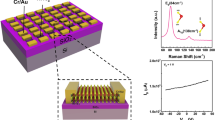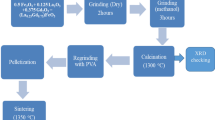Abstract
Based on the principle of maximum bond energy, a structural model is proposed for Si3N4 + 60 wt % MoSi2 + 5 wt % Y2O3 + 1.5 wt % Al2O3 ceramics. In this model, Si3N4 clusters form a star-like structure with columnar pores 0.45 and 1.5 nm in size. The smaller pores are filled with MoSi2 molecules, and the larger pores are filled with Y2O3 and Al2O3 clusters. The solubility of MoSi2 molecules in silicon nitride is 70 wt %, and those of Y2O3 and Al2O3 are 5.45 wt %. The energies of intercluster interaction in two mutually perpendicular directions are 3.2 and 5.5 eV, which is comparable to bond energies in structural metallic materials. The lattice parameters of molybdenum disilicide are determined by x-ray diffraction. The formation of MoO3 and SiO2 molecules during thermal cycling has an insignificant effect on the structure of the material.
Similar content being viewed by others
REFERENCES
Vityaz’, P.A., Golubtsova, E.S., Kaledin, B.A., and Ritzhaupt-Kleissl, H.-J., Struktura i svoistva konstruk-tsionnoi keramiki na osnove sialonov (Structure and Properties of Structural Sialon Ceramics), Minsk: Tekhnoprint, 2002.
Grechikhin, L.I. and Ivashchenko, S.A., Energy of Interparticle Interaction during Plasma Deposition, Vestsi Natsl. Akad. Navuk Belarusi, Ser. Fiz.-Tekh. Navuk, 2002, no. 4, pp. 11–17.
Vityaz’, P.A., Golubtsova, E.S., and Grechikhin, L.I., Mechanism of Formation of Silicon-Nitride-Based Nanoceramics: I. General Description of a Two-Particle Quantum-Mechanical Model, Vestsi Natsl. Akad. Navuk Belarusi, Ser. Fiz.-Tekh. Navuk, 2004, no. 2, pp. 5–10.
Kanamaru Moriyoshi, Untersuchungen zur Gefugeentwicklung von Si3N4-Keramiken mit selten Erdoxiden, Doktorarbeit der Naturwissenschaften, Stuttgart, 1994.
Rigel, G., Bestgen, H., and Herrmann, M., Influence of Sintering Additives with Differing Proportions of Y2O3 /Al2O3 on the Sintering and Material Properties of Si3N4 Ceramics, Ber. Dtsch. Keram. Ges., 1998, vol. 75, no. 10, pp. 30–34.
Sun, E.Y., Becher, P.F., Plucknett, K.P., et al., Microstructural Design of Silicon Nitride with Improved Fracture Toughness: II. Effects of Yttria and Alumina Additives, J. Am. Ceram. Soc., 1998, vol. 81, no. 11, pp. 2831–2840.
Golubtsova, E.S., Afits. Byull., 2004, no. 1, p. 35.
Kurokawa, K., Houzumi, H., Saeki, I., and Takahashi, H., Low Temperature Oxidation of Fully Dense and Porous MoSi2, Mater. Sci. Eng., A, 1999, vol. 261, pp. 292–299.
Rautsig, A.A. and Smirnov, B.M., Spravochnik po atomnoi i molekulyarnoi fizike (Handbook of Atomic and Molecular Physics), Moscow: Atomizdat, 1980.
Author information
Authors and Affiliations
Additional information
Translated from Neorganicheskie Materialy, Vol. 41, No. 2, 2005, pp. 185–192.
Original Russian Text Copyright© 2005 by Grechikhin, Golubtsova.
Rights and permissions
About this article
Cite this article
Grechikhin, L.I., Golubtsova, E.S. Silicon-nitride-based nanoceramic materials. Inorg Mater 41, 140–147 (2005). https://doi.org/10.1007/s10789-005-0033-0
Received:
Revised:
Issue Date:
DOI: https://doi.org/10.1007/s10789-005-0033-0




